7.3 Stability
Learning Objectives
By the end of this section, you will be able to:
- State the types of equilibrium.
- Describe stable and unstable equilibriums.
- Describe neutral equilibrium.
It is one thing to have a system in equilibrium; it is quite another for it to be stable. The toy doll perched on the man’s hand in Figure 7.9, for example, is not in stable equilibrium. There are three types of equilibrium: stable, unstable, and neutral. Figures throughout this module illustrate various examples.
Figure 7.9 presents a balanced system, such as the toy doll on the man’s hand, which has its center of gravity (cg) directly over the pivot, so that the torque of the total weight is zero. This is equivalent to having the torques of the individual parts balanced about the pivot point, in this case the hand. The cgs of the arms, legs, head, and torso are labeled with smaller type.
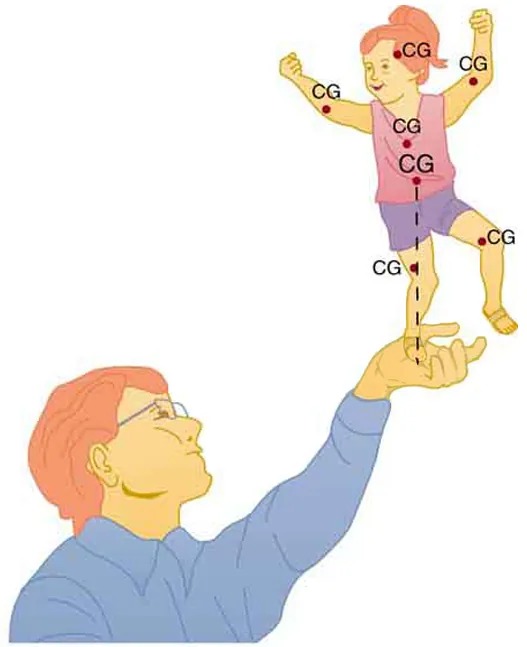
Figure 7.9 A man balances a toy doll on one hand. Image from OpenStax College Physics 2e, CC-BY 4.0
Image Description
The image depicts an illustration of a person holding a child on the palm of their hand. The person appears to be looking upwards at the child while they steady them. The child, standing on one foot, has their arms raised in a balancing pose. Several red dots labeled “CG” are marked along the child’s body, indicating the concept of “center of gravity.” These dots are shown on various points of the child’s body: the head, arms, torso, and legs. A dashed line runs through the labeled points, suggesting the alignment of the center of gravity. The illustration conveys a balance or physics concept, emphasizing how the center of gravity allows the child to balance on the person’s hand.
A system is said to be in stable equilibrium if, when displaced from equilibrium, it experiences a net force or torque in a direction opposite to the direction of the displacement. For example, a marble at the bottom of a bowl will experience a restoring force when displaced from its equilibrium position. This force moves it back toward the equilibrium position. Most systems are in stable equilibrium, especially for small displacements. For another example of stable equilibrium, see the pencil in Figure 9.10.
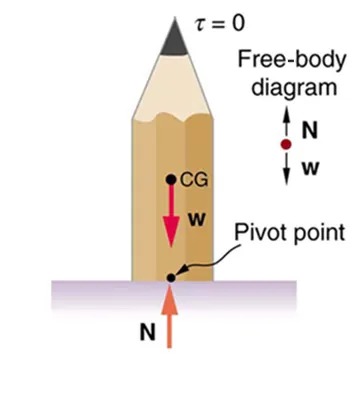
Figure 7.10 This pencil is in the condition of equilibrium. The net force on the pencil is zero and the total torque about any pivot is zero. Image from OpenStax College Physics 2e, CC-BY 4.0
Image Description
The image shows a diagram of a pencil representing a physics concept. The pencil is oriented vertically on a surface. Various labels and symbols are used to illustrate the forces and points of interest:
- The pencil is shaded light brown with a sharpened graphite tip at the top.
- At the center of the pencil, there is a black dot labeled “CG,” indicating the center of gravity.
- A red arrow pointing downward from “CG” is labeled “w,” representing the weight of the pencil.
- There is a small black dot at the bottom of the pencil, labeled as the “Pivot point.”
- An orange arrow pointing upward from the “Pivot point” is labeled “N,” indicating the normal force exerted by the surface.
- To the right of the pencil, there is a simple free-body diagram with two vertical arrows: one arrow pointing upward labeled “N” and one pointing downward labeled “w.”
- At the top left, the Greek letter “τ” is shown followed by “= 0,” indicating that the torque is zero.
A system is in unstable equilibrium if, when displaced, it experiences a net force or torque in the same direction as the displacement from equilibrium. A system in unstable equilibrium accelerates away from its equilibrium position if displaced even slightly. An obvious example is a ball resting on top of a hill. Once displaced, it accelerates away from the crest. See the next several figures for examples of unstable equilibrium.
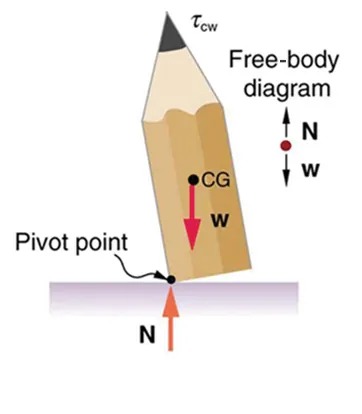
Figure 7.11 If the pencil is displaced slightly to the side (counterclockwise), it is no longer in equilibrium. Its weight produces a clockwise torque that returns the pencil to its equilibrium position. Image from OpenStax College Physics 2e, CC-BY 4.0
Image Description
The image is a diagram of a pencil standing vertically on a flat surface, illustrating the concepts of force and torque in a free-body diagram.
– The pencil is slightly tilted and is in contact with the surface at a point labeled “Pivot point.”
– The center of gravity (CG) of the pencil is marked with a black dot and labeled “CG.”
– A red arrow pointing downward from the CG indicates the weight of the pencil, labeled “w.”
– An upward red arrow from the pivot point represents the normal force, labeled “N.”
– A curved arrow near the tip of the pencil indicates clockwise torque, labeled “τcw.”
– To the side of the pencil, a simplified free-body diagram is shown, consisting of two vertical arrows: an upward arrow for “N” and a downward arrow for “w.”
Overall, the diagram demonstrates how forces and torque act on the pencil, with a focus on the balance of these forces around the pivot point.
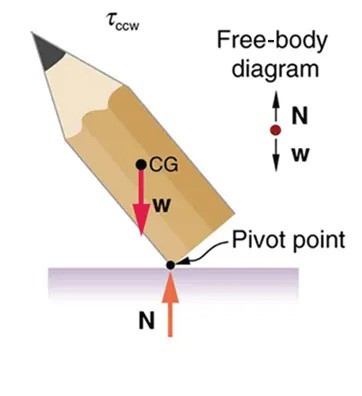
Figure 7.12 If the pencil is displaced too far, the torque caused by its weight changes direction to counterclockwise and causes the displacement to increase. Image from OpenStax College Physics 2e, CC-BY 4.0
Image Description
The image is a diagram depicting the forces acting on a pencil that is balanced on its tip, labeled as a “Free-body diagram.”
– Pencil: The pencil is oriented diagonally, pointing upward to the left, and resting on a pivot point.
– Pivot Point: Located at the bottom where the pencil meets a surface.
– Center of Gravity (CG): Marked on the pencil with a black dot labeled “CG.”
– Forces: Two forces are acting on the pencil:
– Weight (w): Represented by a downward arrow from the center of gravity, labeled “w.”
– Normal Force (N): Represented by an upward arrow at the pivot point, labeled “N.”
– Torque (τccw): There is a label τccw near the top of the pencil indicating a counterclockwise torque.
– There is a small free-body diagram to the side showing:
– A red dot with two arrows, one pointing up labeled “N” and one pointing down labeled “w,” demonstrating the balance of forces.
Overall, this image illustrates the concept of forces and torque in a balanced object scenario.
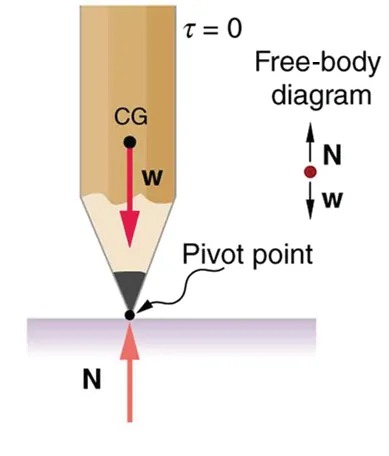
Figure 7.13 This figure shows unstable equilibrium, although both conditions for equilibrium are satisfied. Image from OpenStax College Physics 2e, CC-BY 4.0
Image Description
The image is a diagram showing the physics of a pencil balanced on its tip, illustrating concepts of torque and forces. The pencil is positioned vertically with its tip resting on a surface, acting as the pivot point.
A red arrow labeled “w” is directed downward from the pencil’s center of gravity (CG), representing the weight of the pencil. At the base, near the tip, another red arrow labeled “N” points upward, representing the normal force exerted by the surface. These arrows illustrate the balance of forces at play.
There is a small section to the top right containing a simplified “Free-body diagram.” It shows two arrows: one pointing upward labeled “N” and another pointing downward labeled “w,” reinforcing the direction of the forces acting on the pencil.
The notation “τ = 0” indicates that the torque is zero, highlighting the equilibrium condition where the pencil balances due to the equal weight and normal forces. A curved arrow points to the tip of the pencil, indicating the pivot point.
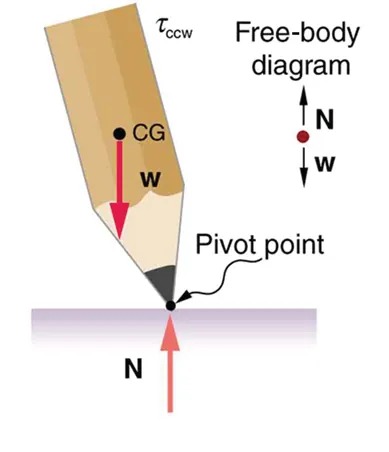
Figure 7.14 If the pencil is displaced even slightly, a torque is created by its weight that is in the same direction as the displacement, causing the displacement to increase. Image from OpenStax College Physics 2e, CC-BY 4.0
Image Description
The image depicts a simple physics diagram demonstrating the concept of torque and balance with a pencil.
– Pencil Illustration: A pencil is shown resting on a surface at an angle. The eraser end is elevated while the point touches the surface, designated as the “Pivot point.”
– Center of Gravity (CG): A black dot with the label “CG” is marked on the pencil, indicating the center of gravity with a red arrow labeled “w” pointing downwards, signifying the weight force acting through the center of gravity.
– Normal Force (N): A red arrow labeled “N” points upwards from the pivot point, representing the normal force exerted by the surface on the pencil.
– Torque (τ_ccw): Above the pencil, the symbol “τ_ccw” is shown, suggesting counterclockwise torque acting on the pencil around the pivot point.
– Free-body Diagram: Located to the right of the pencil, a simplified free-body diagram illustrates the forces. It includes:
– A dot with a small arrow pointing upwards labeled “N” for the normal force.
– A dot with a small arrow pointing downwards labeled “w” for the weight.
This image demonstrates the balance of forces and the creation of torque as the pencil rests at an angle on a surface.
A system is in neutral equilibrium if its equilibrium is independent of displacements from its original position. A marble on a flat horizontal surface is an example. Combinations of these situations are possible. For example, a marble on a saddle is stable for displacements toward the front or back of the saddle and unstable for displacements to the side. Figure 7.15 shows another example of neutral equilibrium.
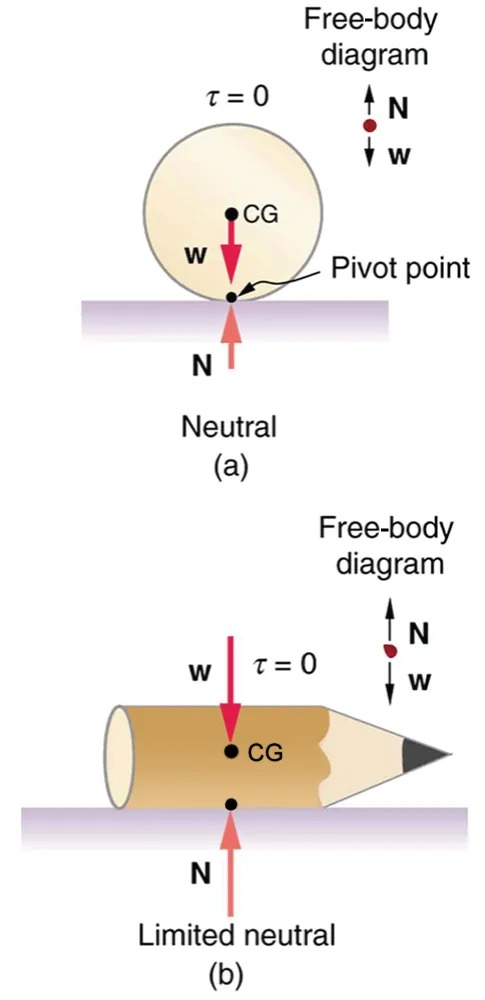
Figure 7.15 (a) Here we see neutral equilibrium. The cg of a sphere on a flat surface lies directly above the point of support, independent of the position on the surface. The sphere is therefore in equilibrium in any location, and if displaced, it will remain put. (b) Because it has a circular cross section, the pencil is in neutral equilibrium for displacements perpendicular to its length. Image from OpenStax College Physics 2e, CC-BY 4.0
Image Description
The image consists of two diagrams labeled (a) and (b), depicting free-body diagrams of different objects on a surface.
Diagram (a) – Neutral:
– Object: A circle is balanced on a surface with a pivot point at the bottom.
– Labels:
– “CG” marks the center of gravity inside the circle.
– “w” is a downward arrow representing weight, pointing from the CG to the surface.
– “N” is an upward arrow representing the normal force, acting through the pivot point.
– “τ = 0” indicates zero torque.
– A small sub-diagram to the side shows two arrows: “N” pointing up and “w” pointing down.
Diagram (b) – Limited Neutral:
– Object: A pencil-shaped object is balanced horizontally on a surface.
– Labels:
– “CG” marks the center of gravity inside the pencil.
– “w” is a downward arrow representing weight, pointing from the CG to the surface.
– “N” is an upward arrow representing the normal force, acting through the base of the pencil.
– “τ = 0” indicates zero torque.
– A small sub-diagram to the side similar to the first diagram shows two arrows: “N” pointing up and “w” pointing down.
Both diagrams illustrate the balance of forces and torque where the weight and normal force are equal in magnitude and opposite in direction, resulting in no torque.
When we consider how far a system in stable equilibrium can be displaced before it becomes unstable, we find that some systems in stable equilibrium are more stable than others. The pencil in Figure 7.10 and the person in Figure 7.16(a) are in stable equilibrium, but become unstable for relatively small displacements to the side. The critical point is reached when the cg is no longer above the base of support. Additionally, since the cg of a person’s body is above the pivots in the hips, displacements must be quickly controlled. This control is a central nervous system function that is developed when we learn to hold our bodies erect as infants. For increased stability while standing, the feet should be spread apart, giving a larger base of support. Stability is also increased by lowering one’s center of gravity by bending the knees, as when a football player prepares to receive a ball or braces themselves for a tackle. A cane, a crutch, or a walker increases the stability of the user, even more as the base of support widens. Usually, the cg of a female is lower (closer to the ground) than a male. Young children have their center of gravity between their shoulders, which increases the challenge of learning to walk.
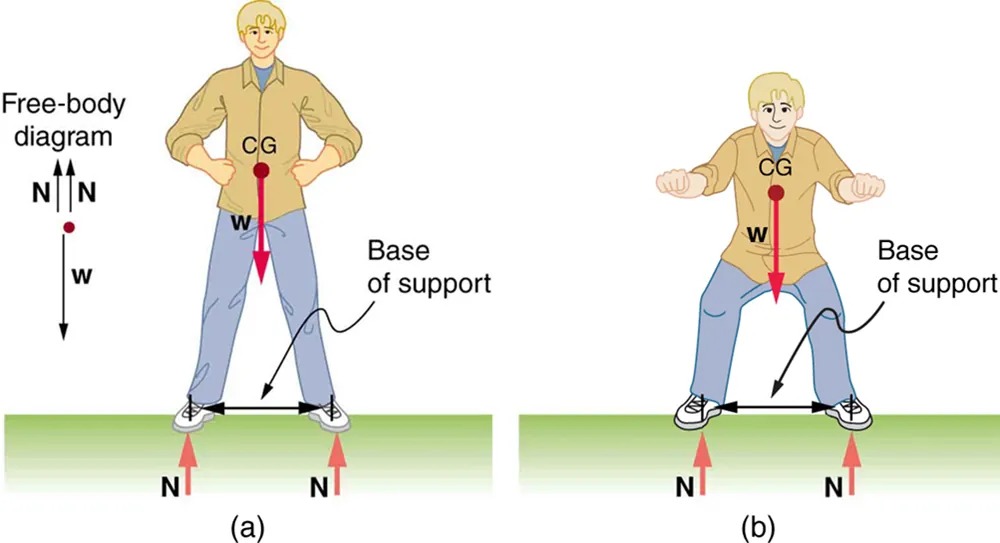
Figure 7.16 (a) The center of gravity of an adult is above the hip joints (one of the main pivots in the body) and lies between two narrowly-separated feet. Like a pencil standing on its eraser, this person is in stable equilibrium in relation to sideways displacements, but relatively small displacements take his cg outside the base of support and make him unstable. Humans are less stable relative to forward and backward displacements because the feet are not very long. Muscles are used extensively to balance the body in the front-to-back direction. (b) While bending in the manner shown, stability is increased by lowering the center of gravity. Stability is also increased if the base is expanded by placing the feet farther apart. Image from OpenStax College Physics 2e, CC-BY 4.0
Image Description
The image contains two diagrams labeled (a) and (b), both depicting a person standing and demonstrating concepts related to center of gravity and base of support.
Diagram (a):
– The person is standing upright with their feet shoulder-width apart.
– A red dot marked “CG” indicates the center of gravity near the stomach area.
– A red downward arrow labeled “w” represents the weight of the person, originating from the center of gravity.
– Black arrows labeled “N” originate from the feet, pointing upwards, representing the normal force from the ground.
– A horizontal double-headed arrow between the feet marks the “Base of support.”
– A separate “Free-body diagram” is shown on the left with a red dot and the same vertical arrows for weight (w) and normal force (N).
Diagram (b):
– The person is bending slightly with feet spread further apart than in (a).
– The center of gravity (CG) and weight (w) are indicated similarly as in (a), with the weight arrow pointing down from the center of gravity.
– The base of support is shown as wider than in (a) with the horizontal double-headed arrow between the feet.
– Upward arrows labeled “N” are again shown at the feet to depict the normal force.
The image illustrates how altering foot positioning can affect stability by changing the base of support, while maintaining the center of gravity concept in both scenarios.
Animals such as chickens have easier systems to control. Figure 7.17 shows that the cg of a chicken lies below its hip joints and between its widely separated and broad feet. Even relatively large displacements of the chicken’s cg are stable and result in restoring forces and torques that return the cg to its equilibrium position with little effort on the chicken’s part. Not all birds are like chickens, of course. Some birds, such as the flamingo, have balance systems that are almost as sophisticated as that of humans.
Figure 7.17 shows that the cg of a chicken is below the hip joints and lies above a broad base of support formed by widely-separated and large feet. Hence, the chicken is in very stable equilibrium, since a relatively large displacement is needed to render it unstable. The body of the chicken is supported from above by the hips and acts as a pendulum between the hips. Therefore, the chicken is stable for front-to-back displacements as well as for side-to-side displacements.
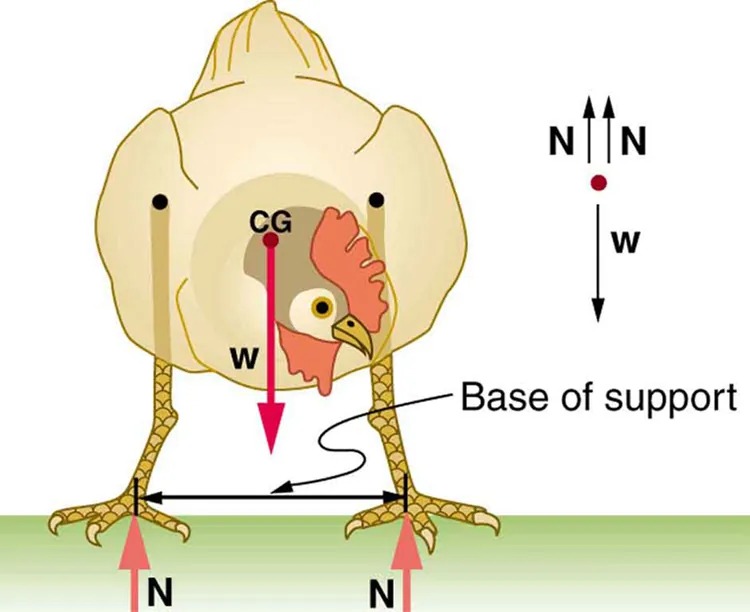
Figure 7.17 The center of gravity of a chicken is below the hip joints. The chicken is in stable equilibrium. The body of the chicken is supported from above by the hips and acts as a pendulum between them. Image from OpenStax College Physics 2e, CC-BY 4.0
Image Description
This image illustrates a chicken and demonstrates the concept of balance and support. The chicken’s body is shown with its legs spread apart, standing on a flat green surface.
– A red dot labeled “CG” indicates the center of gravity inside the chicken’s body.
– A downward arrow labeled “W” points from the CG, representing the weight force acting downwards.
– Two upward arrows labeled “N” are positioned under each foot, showing the normal force exerted by the ground on the chicken’s feet.
– The phrase “Base of support” is marked by a double-headed arrow that spans the distance between the chicken’s feet.
– To the right of the chicken, another diagram shows the same forces: “N” for normal force directed upward and “w” for weight directed downward.
This visualization explains how the chicken maintains balance by aligning the center of gravity over its base of support, counteracting its weight with normal forces from the ground.
Engineers and architects strive to achieve extremely stable equilibriums for buildings and other systems that must withstand wind, earthquakes, and other forces that displace them from equilibrium. Although the examples in this section emphasize gravitational forces, the basic conditions for equilibrium are the same for all types of forces. The net external force must be zero, and the net torque must also be zero.
Take-Home Experiment
Stand straight with your heels, back, and head against a wall. Bend forward from your waist, keeping your heels and bottom against the wall, to touch your toes. Can you do this without toppling over? Explain why and what you need to do to be able to touch your toes without losing your balance. Is it easier for a woman to do this?

